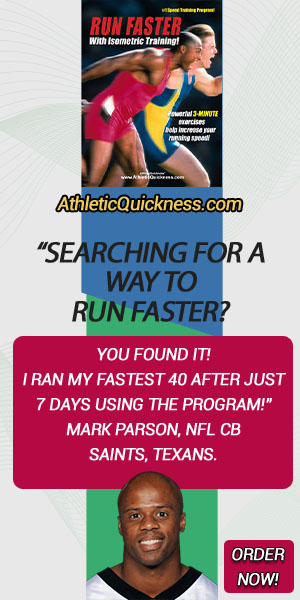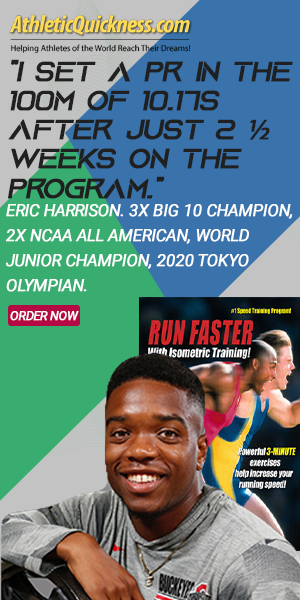The best way to increase your running stride and turnover rate is to develop strong hip flexor muscles. These are powerful and long muscles in the front side of your pelvic region. The main function is to flex the thigh up on the pelvis seen in Figure 1. They are capable of generating enormous thrust into the midsection of the body to help with your speed and power to run.

Figure 1. The Stride Powered by the Hip Flexor Muscles
Quite possibly the most overlooked phase in running by athletes on all levels, the Swing Phase is the only phase that takes place during the running motion where the foot is off the ground.
Also known as your stride, the Swing Phase begins immediately after the Push Phase has ended. It starts the moment the foot leaves the ground behind you and continues all the way through until this same foot lands and touches the ground in front of you.
Looking at figure 2-1a below, we can see the start of the swing phase where the right foot has just left the ground.
In Figure 2-1b the right thigh and leg are now airborne and are being pulled forward. This is the main function of your hip flexor muscles.
In Figure 2-1c the right thigh continues to be pulled forward as well as upward. Again, this is the main function of your hip flexor muscles.
Finally, in Figure 2-1d, the right knee extends the lower leg and foot out in front of the runner so that he can make proper contact with the ground when he lands. This is the main function of the knee extensors, or quadriceps.

The Swing Phase involves a pulling-type of force. Pulling forces are forces that cause motion toward the source of the force. The source of the force here are the hip flexor muscles located predominantly in front of the hip joint.
With the right leg trailing behind the runner at the start in our example here (Figure 2-1a), the hip flexors in front of the body will have to pull the weight of the entire leg forward, or toward them. Therefore, the Swing Phase is predominantly a pulling motion.
As seen above, your hip flexor muscles dominate this Swing Phase of running and contrary to what many people might think, these muscles are not small, but rather, they are some of the longest muscles in the body.
Their names are: Psoas, Sartorius, Pectineus, Rectus Femoris, Adductor Brevis, Adductor Longus and iliacus. The positions of these muscles are outlined in yellow in Figure 3 below:

So Long and So Strong
As you can see, your hip flexor muscles cover the length of about half of your body. This is quite a substantial distance and major source of your running speed if only you can tap into it.
The Psoas muscle is the highest up in the body of all the hip flexors starting in the lower part of your thoracic spine at the transverse process of the 12th thoracic (dorsal) vertebrae.
The Sartorius muscle, the longest in the body, starts out on the anterior and superior aspect of the ilium and inserts just below the knee joint. It spans both the hip and knee joint in the process and therefore produces action on both.
As a group, your hip flexor muscles are also some of the strongest muscles in the body. They are responsible walking and running. Just take a look at their effect in Figure 4 below! And to think you may be walking out of the gym every single day not even paying any attention to them.

The amount of horsepower (your rate of work) that these muscles are capable of generating is enormous. But since they are essentially hidden deep within the midsection of your body, they usually go un-exercised.
This means that in all likelihood, your very own hip flexor muscles are presently sitting dormant inside you and this means they have not yet been activated for speed or exercised for any true athletic function other than walking.
Some people think that doing regular sit-ups or hanging leg lifts is sufficient exercise for these muscles, but there are at least two problems with those exercises for hip flexor development.
One is they can’t engage the hip flexors with a long enough lever in the body, such as the entire length of the leg, to put any significant force on them other than your own body weight. This is a big mistake to make because these muscles are capable of so much more.
And two, those exercises don’t engage the hip flexors long enough through their peak force for them to have any substantial effect on them. The amount of time these muscles undergo any peak force with a sit-up or hanging leg lift (which is still considerably less than the peak force attainable in them) is usually about a half of second. This is nowhere near long enough to properly develop these long strong muscles.
Not to mention a lot of these types of exercises are not done properly where people may cheat a little and use the momentum created by their upper body or legs and swing themselves through the exercise.
But if you just stop and consider the shear length and number (7 on each side for a total of 14!) of these muscles and their purpose in the running process, you would be seriously mistaken not to search for a better way to engage them. After all, these muscles are responsible for the speed and length of your stride which helps determine your turnover rate as well as the distance you will cover with each step.
But if the leg is off the ground and not pushing, what’s the big deal?
This argument comes up a lot and unfortunately at the expense of any athlete who chooses to overlook the importance of the Swing Phase and the hip flexors role in it. Just because the leg is off the ground doesn’t mean it no longer has any effect on your running speed; quite the opposite.
If an athlete weighs 180 lbs., you can estimate the weight of each of his legs at around 40-45 lbs. This is quite a bit of weight to pull continuously during the swing phase of the running process.
If you hip flexors are not conditioned to pull this weight, you will always feel like you are you stuck in second gear or are running with lead in your pants because you can’t pull your leg from behind you and extend it out in front of you as fast as you would like.
This problem is further compounded when you think about all the attention the hip extensors on the back side of your body and knee extensors are getting. With all the exercise they get, they are getting bigger and stronger which also means they are getting heavier.
But as good as it is for them and the Push Phase, you still have to be able to pull that leg forward during the swing phase. And with the extra weight through muscle development that takes place on the back side of the body near your buttocks and the front side around your knees, the weak hip flexors will suffer even more.
This is why it is not uncommon for people who over-train their hip extensors and knee extensors to sometimes end up slower in the process. They aren’t able to effectively carry their body weight anymore because the hip flexors can’t match the extra demand the weight of those muscles require.
Think of it this way – not training your hip flexors properly for running is not much different than trying to run your very best with 5 lbs. dumbbells in each hand. If you’re not prepared to carry the extra weight then you shouldn’t expect to run your fastest times.
So, the key here is balance within all of the muscles involved in running and the best way to attack your hip flexors and get them up to speed is to use the resistance band with an isometric training strategy as shown in this exercise.
It is an incredibly efficient exercise and one that you can expect to make a big difference in your running speed and turnover rate in just a few days.



